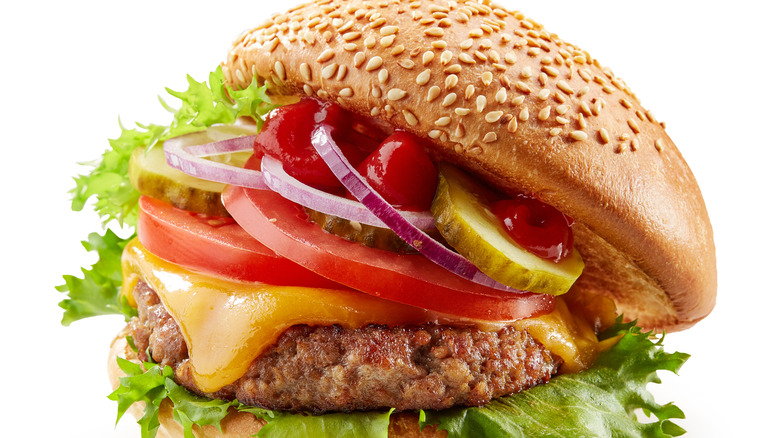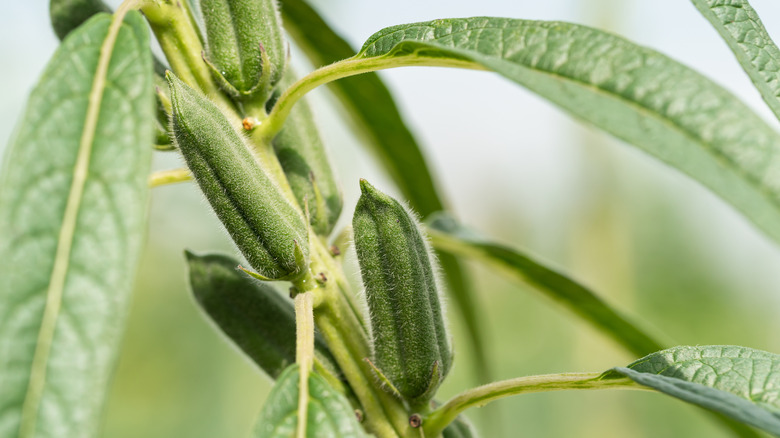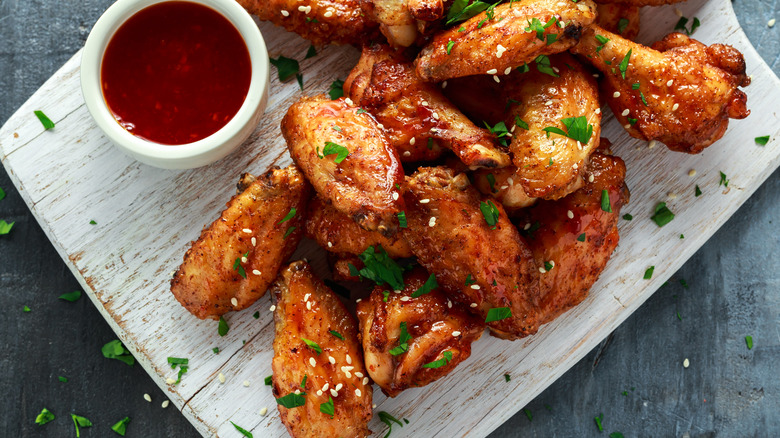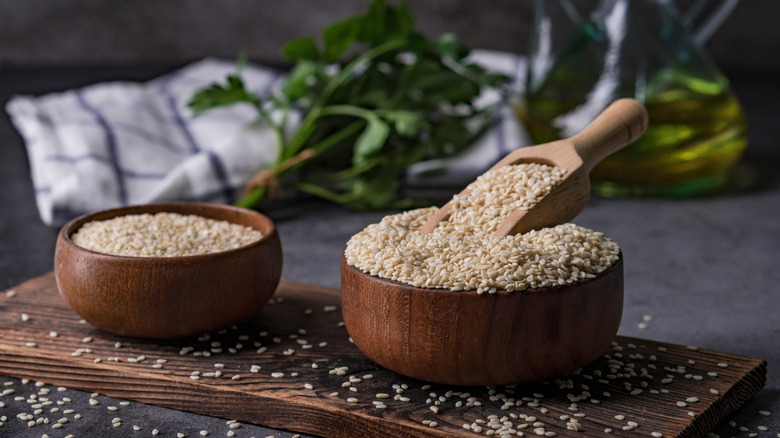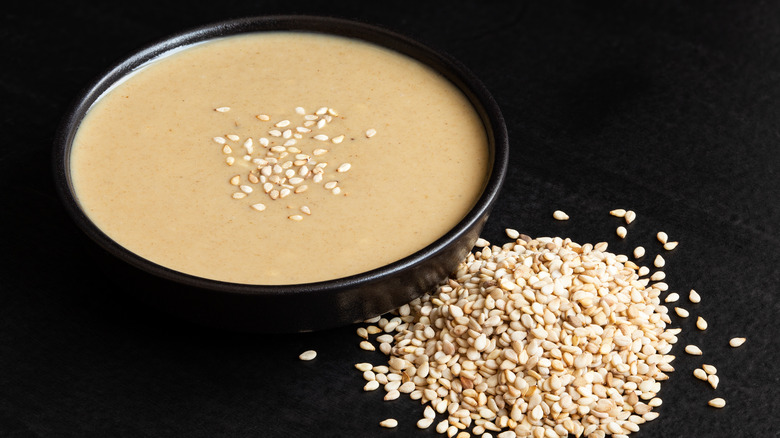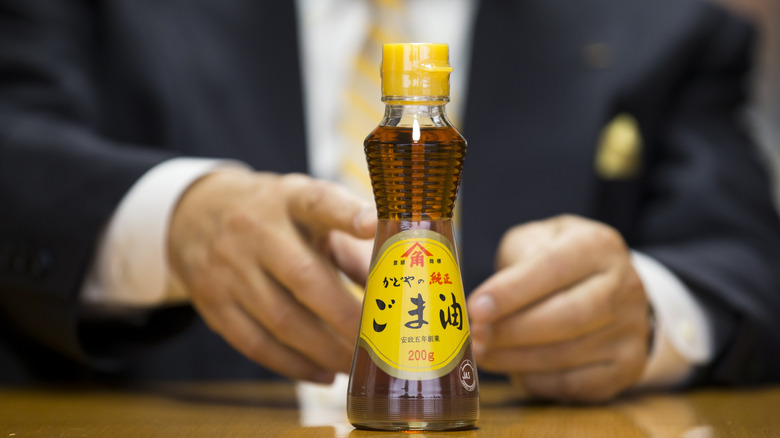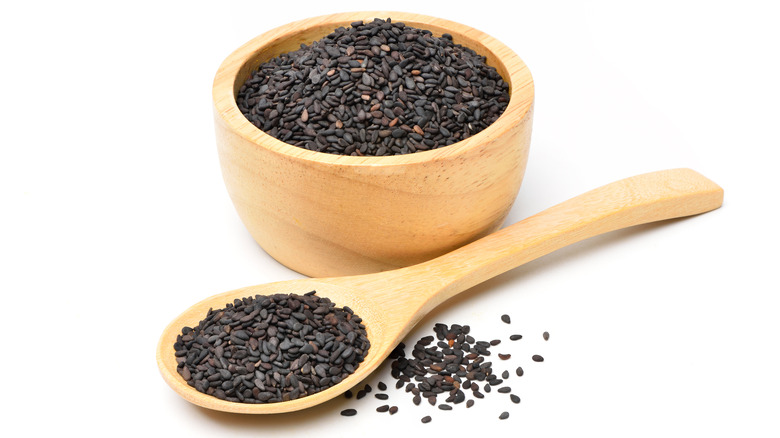What Are Sesame Seeds And Can You Eat Them Raw?
We may receive a commission on purchases made from links.
If you've ever eaten a classic McDonald's Big Mac, you probably have a good appreciation for sesame seeds. The burger chain had so much admiration in fact, they included the little morsels in the now-famous jingle — the one that goes, "Two all-beef patties, special sauce, lettuce, cheese, pickles, onions, on a sesame-seed bun" (via Love Food). But, if you think that's all sesame seeds are known for — adding some color and texture to a burger bun — there's so much more to get to know about these unassuming but ultimately impressive little foodstuffs.
Sesame seeds come from the sesame plant, also known as Sesamum indicum, which is an annual flowering species that grows in tropical and subtropical parts of the world (via Britannica) and produces these highly prized seeds. While they're often cooked and processed for various dishes — sesame seed oil is also a commodity — you can just as well eat raw sesame seeds and may be able to benefit from the many nutritional qualities they impart like healthy fats, protein, fiber, and "more calcium than an 8-ounce cup of milk" in just a quarter-up, says Food Network.
However, while it is safe to eat raw sesame seeds, they offer even more nutritional value when they have been crushed or pulverized, and the seeds provide a ton more flavor when they have been cooked, pressed, and blended with other ingredients. For a little seed, they truly have so much to give us.
Where do sesame seeds come from?
Sesame seeds come from the sesame plant, which is also often called benne. The seeds themselves come from large pods that grow on the plant, the stalks of which can get as tall as nine feet in some cases (via Britannica). Sesame plants grow well in tropical, subtropical, and some temperate zones of the planet, with the current leading producer being Myanmar. That country produced more than 758,000 metric tons of sesame seeds in the year 2019, according to Nation Master. India is a close second, having produced more than 755,300 metric tons of sesame seeds during that same year.
When harvested by hand, sesame seeds are collected by gathering the pods off the stalk of the plant and then letting them dry out (via Hobby Farms). Once each pod is dry, it can be cracked open and the seeds are released, though they will need to be separated from the inedible chaff — this can be done by passing the seeds through the mesh of a colander or by brushing and blowing the chaff away from seeds when spread out on a flat surface.
On a commercial scale, sesame seeds are collected by a mechanical combine, usually one that has been specially outfitted for the collection of such small particles that would otherwise be at risk for falling out or getting lost in the nooks and crannies (via Gardening Know How).
Sesame seeds in many ways are as old as time — there's records of China using them as long as 5,000 years ago, with the oil being burned for ink blocks according to Britannica. And ancient Egyptians ground up the seeds for flour while Romans pulverized them into a paste with added cumin for a bread topping, not unlike tahini. At one point in history, sesame was even believed to have magical powers — hence the saying "open sesame" made famous in the story of "Ali Baba and the Forty Thieves."
How to incorporate sesame seeds into your cooking
Sesame seeds are super healthy and, for that reason alone, they are a great addition to any diet. They can also be a delicious add-on to many dishes.
One of the most popular uses for sesame seeds is in making a crust for meats, seafood, and tofu (via NDTV Food). After picking your protein source (great options include chicken, salmon, shrimp, and beef), you'll want to coat it in some sort of sticky sauce, like honey or an orange glaze. Then, simply roll each piece in raw sesame seeds — they will stick to the surface — and then cook the food as you normally would. The result will be some added crunch and a bit of smoky, nutty taste. Sesame seeds are also great on cooked vegetables, like broccoli or kale (via Jamie Oliver).
Adding sesame seeds to a smoothie or on top of yogurt is another great way to get some additional protein and other nutrients, or simply sprinkle them over a salad for extra crunchy texture. Tahini is also a popular way to use sesame seeds — the thin paste made from crushed seeds is used in hummus and can be a great salad dressing too. In the Middle East, the fudge-like dessert halva also uses tahini as a main ingredient, per Britannica.
You can also make a homemade nut milk with sesame seeds, which can be used like almond or soy milk or any other dairy alternative. To do so, says Food Network, soak one cup of sesame seeds in two cups of milk overnight, then process the mixture in a blender in the morning, and strain through a cheesecloth.
The health benefits of sesame seeds
While these seeds may be small in size, they are big in nutrition. Just three large tablespoons of sesame seeds (or 30 grams) can impart a wealth of vitamins, minerals, and other nutrients, according to Healthline, including 5 grams of protein, 3.5 grams of fiber, and quite a bit of good-for-you polyunsaturated and monounsaturated fats, which may help lower cholesterol.
That same serving size will also deliver 21% of your daily recommended intake of zinc, 22% of the daily required amount of calcium, 25% of magnesium, and 32% manganese. (Note that these figures are for unhulled sesame seeds, which are the superior choice — hulled sesame seeds are lower in zinc, manganese, and magnesium and have almost no calcium.) Sesame seeds are also a great source of several B vitamins and thiamin and deliver good amounts of iron and copper.
Regularly eating sesame seeds may also reduce inflammation in the body, says Healthline, and could possibly aid in the production of red blood cells. The antioxidant properties have also been seen to fight off cancer-causing free radicals.
More about tahini and how it's made
Simply put, sesame seeds are to tahini as peanuts are to peanut butter. Tahini is made from ground up sesame seeds and, in many cases, nothing more. It is a rich, viscous, and oily substance that can be a healthy dip, a salad dressing, a drizzle for meats or veggies, or a sauce in wraps, among other ideas. In some recipes, additional oils are added to tahini, while others add salt to the sesame seeds to make this paste. But in plenty of other instances, the only ingredient used is ground sesame seeds, which makes tahini a clean, whole food.
To make it, sesame seeds are often roasted prior to being ground — this is what gives tahini its brown color. On its own, tahini is a tasty and versatile foodstuff, but it is perhaps best known as being a critical ingredient used in the making of hummus, a food that has surged in popularity in recent years, chiefly because of its nutritional value and great taste (via Entrepreneur).
How to cook with sesame oil
According to archeological evidence, sesame was the first crop to be grown for a cooking oil, says Master Class. And, as many humans have found out over time, it is a versatile and tasty oil that naturally resists turning rancid, and thus can be stored for years and remain ready for use at any time. Due to its price and its low smoke point (or its tendency to burn at lower temperatures), sesame oil is rarely used as a primary cooking agent, but it can be combined with other oils or used in marinades.
Toasted sesame oil (the more commonly used variety, via The Woks of Life) can also be used in sauces, added to soups, and drizzled over and stirred into cooked rice or noodles. Doing so will add flavor and will help prevent starchy foods from sticking together. Sesame oil is also popular with many chefs for adding a special something to cooked vegetables such as green beans, kale, broccoli, carrots, and more (via Food Network).
Sesame oil also makes a great dressing for salads or an add-on to sandwiches and wraps where no cooking is involved, always imparting a light nutty taste that gives dishes an extra oomph.
The difference between black and white sesame seeds
Most Westerners will be more familiar with white sesame seeds than with black sesame seeds, the latter of which are more prevalent in Asia, according to Taste. While there are similarities in taste and nutritional properties — in some recipes, they can be interchangeable — black sesame seeds are distinct from their paler counterparts in notable ways.
One of the most obvious is the marked color difference, which can change the way a completed dish (or dessert or smoothie) appears when it's served. Second, black sesame seeds have a slightly more bitter flavor and a pronounced nuttiness (even when not roasted). That potent taste may be welcome in some recipes but can be a bit overpowering in others.
When it comes to black sesame seeds' nutrition, the comparison is nearly equivalent to white seeds (unhulled, of course). They have roughly the same amount of protein, carbs, and fiber. Like white sesame seeds, black sesame seeds are also a great source of copper, calcium, iron, manganese, and more minerals, and regular consumption may help your body fight off free radicals, could possibly reduce cholesterol and stabilize blood sugar, and supports bone health and immune system function, according to Healthline.
